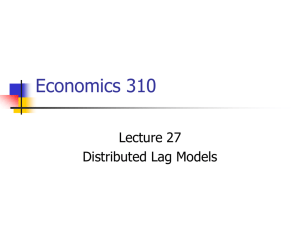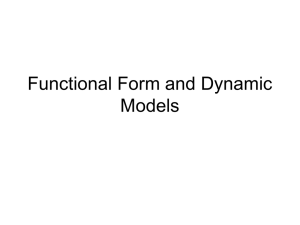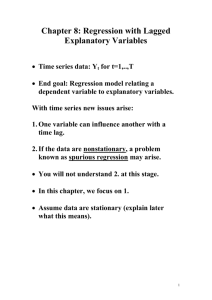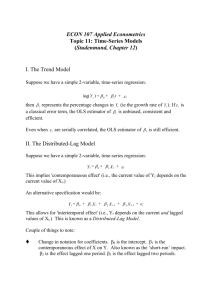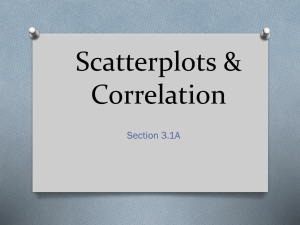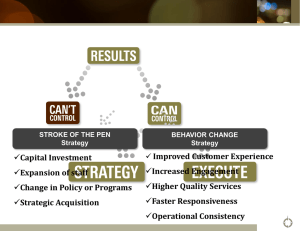autoregressive and distributed-lag models
advertisement
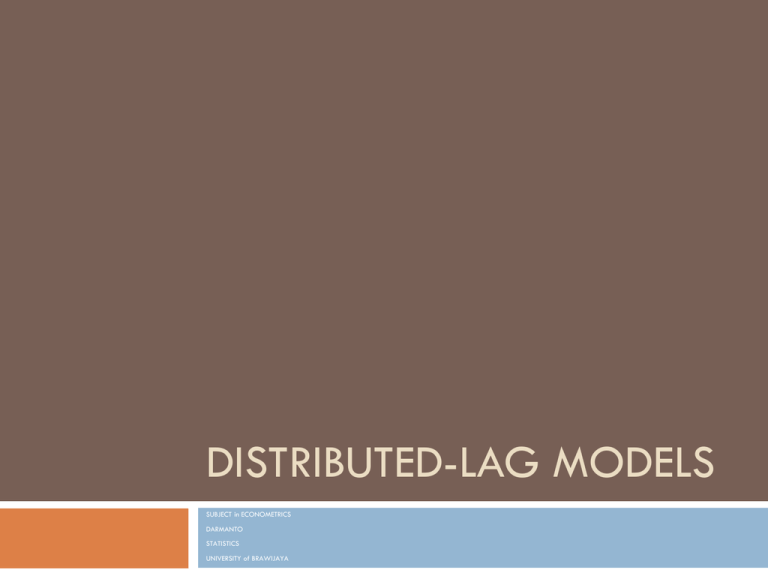
DISTRIBUTED-LAG MODELS SUBJECT in ECONOMETRICS DARMANTO STATISTICS UNIVERSITY of BRAWIJAYA PREFACE... Distributed-lag Model is a model in regression where the model includes not only the current but also the lagged (past) values of the explanatory variables (the X’s). Autoregressive Model is a model thath the model includes one or more lagged values of the dependent variable among its explanatory variables. THE ROLE of LAG in ECONOMICS In economics the dependence of a variable Y (the dependent variable) on another variable(s) X (the explanatory variable) is rarely instantaneous. Very often, Y responds to X with a lapse of time. Such a lapse of time is called a lag. Example: The consumption function Link between money and price Lag between R&D expenditure and productivity The relationship between trade balance and depreciation of currency (J-curve) ESTIMATION of DISTRIBUTED-LAG MODEL Let: ...(1) How do we estimate the α and β’s of (1)? 1. 2. ad hoc estimation a priori restrictions on the β’s by assuming that the β’s follow some systematic pattern. AD HOC ESTIMATION: 1 Since the explanatory variable Xt is assumed to be nonstochastic, Xt−1, Xt−2, and so on, are non-stochastic, too. OLS can be applied (taken by Alt and Tinbergen). They suggest that to estimate (1) one may proceed sequentially; that is, first regress Yt on Xt , then regress Yt on Xt and Xt−1, then regress Yt on Xt , Xt−1, and Xt−2, and so on. This sequential procedure stops when the regression coefficients of the lagged variables start becoming statistically insignificant and/or the coefficient of at least one of the variables changes signs from positive to negative or vice versa. AD HOC ESTIMATION: 2 Example: Alt chose the second regression as the “best’’ one because in the last two equations the sign of Xt−2 was not stable and in the last equation the sign of Xt−3 was negative, which may be difficult to interpret economically. THE KOYCK APPROACH: 1 Suppose we start with the infinite lag distributedlag model. Assuming that the β’s are all of the same sign, Koyck assumes that they decline geometrically as follows. ...(2) where λ, such that 0 <λ< 1, is known as the rate of decline, or decay, of the distributed lag and where 1 − λ is known as the speed of adjustment. THE KOYCK APPROACH: 2 Postulates (2): Each successive β coefficient is numerically less than each preceding β (this statement follows since λ< 1), implying that as one goes back into the distant past, the effect of that lag on Yt becomes progressively smaller, a quite plausible assumption. After all, current and recent past incomes are expected to affect current consumption expenditure more heavily than income in the distant past. THE KOYCK APPROACH: 3 Koyck transformation: ...(3) where vt = (ut − λut−1), a moving average of ut and ut−1. The median and mean lags serve as a summary measure of the speed with which Y responds to X. THE KOYCK APPROACH: 4 THE KOYCK APPROACH: 5 THE ALMON APPROACH: 1 THE ALMON APPROACH: 2 To illustrate her technique, let us revert to the finite distributed-lag model considered previously, THE ALMON APPROACH: 3 THE ALMON APPROACH: 4 THE ALMON APPROACH: 5 THE ALMON APPROACH: 6 THE ALMON APPROACH: 7 THE ALMON APPROACH: 8

